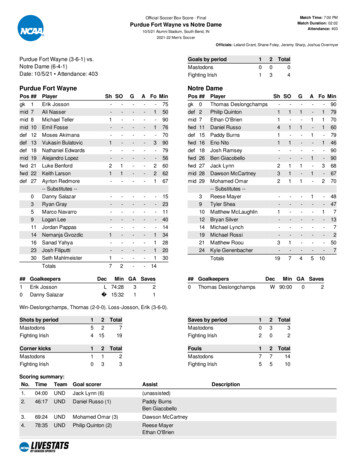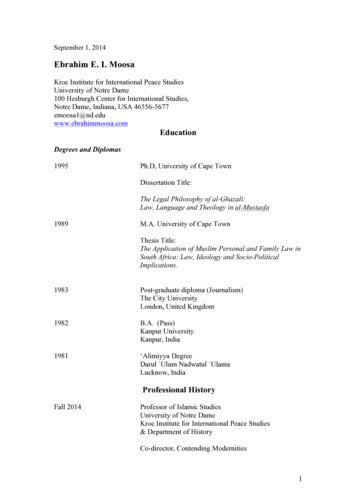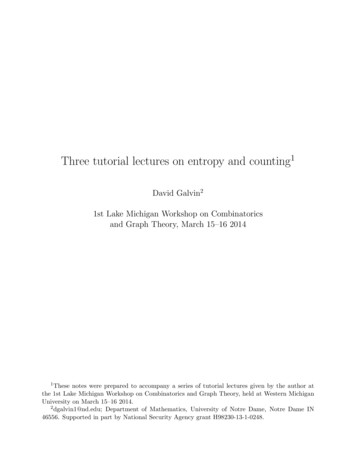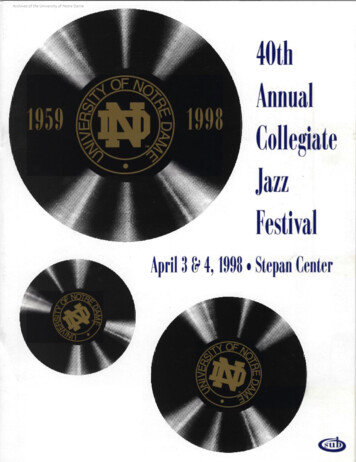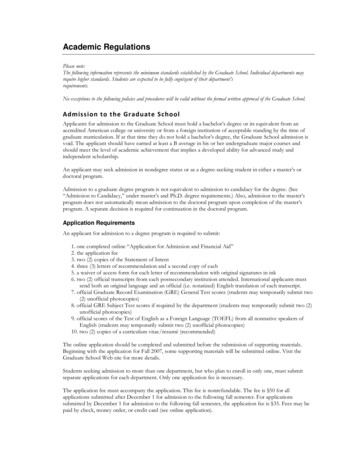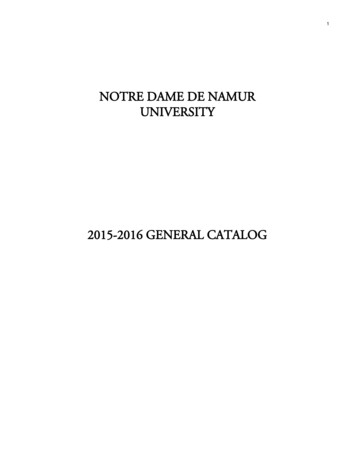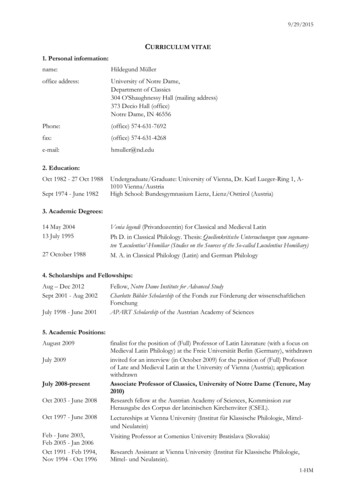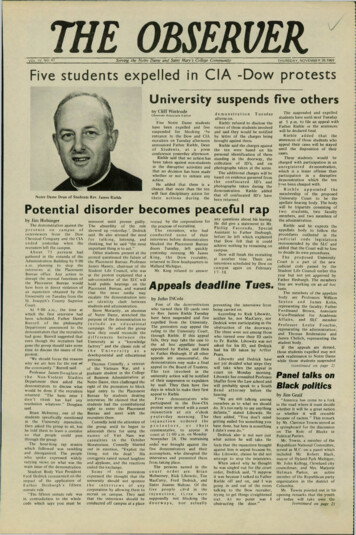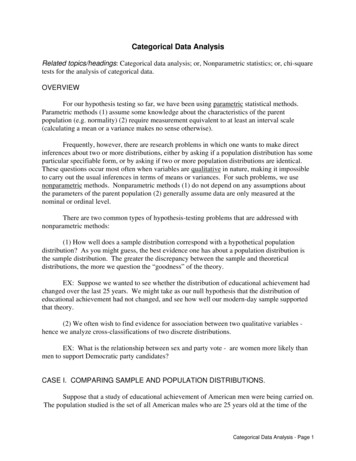
Transcription
Categorical Data AnalysisRelated topics/headings: Categorical data analysis; or, Nonparametric statistics; or, chi-squaretests for the analysis of categorical data.OVERVIEWFor our hypothesis testing so far, we have been using parametric statistical methods.Parametric methods (1) assume some knowledge about the characteristics of the parentpopulation (e.g. normality) (2) require measurement equivalent to at least an interval scale(calculating a mean or a variance makes no sense otherwise).Frequently, however, there are research problems in which one wants to make directinferences about two or more distributions, either by asking if a population distribution has someparticular specifiable form, or by asking if two or more population distributions are identical.These questions occur most often when variables are qualitative in nature, making it impossibleto carry out the usual inferences in terms of means or variances. For such problems, we usenonparametric methods. Nonparametric methods (1) do not depend on any assumptions aboutthe parameters of the parent population (2) generally assume data are only measured at thenominal or ordinal level.There are two common types of hypothesis-testing problems that are addressed withnonparametric methods:(1) How well does a sample distribution correspond with a hypothetical populationdistribution? As you might guess, the best evidence one has about a population distribution isthe sample distribution. The greater the discrepancy between the sample and theoreticaldistributions, the more we question the “goodness” of the theory.EX: Suppose we wanted to see whether the distribution of educational achievement hadchanged over the last 25 years. We might take as our null hypothesis that the distribution ofeducational achievement had not changed, and see how well our modern-day sample supportedthat theory.(2) We often wish to find evidence for association between two qualitative variables hence we analyze cross-classifications of two discrete distributions.EX: What is the relationship between sex and party vote - are women more likely thanmen to support Democratic party candidates?CASE I. COMPARING SAMPLE AND POPULATION DISTRIBUTIONS.Suppose that a study of educational achievement of American men were being carried on.The population studied is the set of all American males who are 25 years old at the time of theCategorical Data Analysis - Page 1
study. Each subject observed can be put into 1 and only 1 of the following categories, based onhis maximum formal educational achievement:1 college grad2 some college3 high school grad4 some high school5 finished 8th grade6 did not finish 8th gradeNote that these categories are mutually exclusive and exhaustive.The researcher happens to know that 10 years ago the distribution of educationalachievement on this scale for 25 year old men was:1 - 18%2 - 17%3 - 32%4 - 13%5 - 17%6 - 3%A random sample of 200 subjects is drawn from the current population of 25 year oldmales, and the following frequency distribution obtained:1 - 352 - 403 - 834 - 165 - 266- 0The researcher would like to ask if the present population distribution on this scale isexactly like that of 10 years ago. That is, he would like to testH0:HA:There has been no change across time. The distribution of education in the presentpopulation is the same as the distribution of education in the population 10 years agoThere has been change across time. The present population distribution differs from thepopulation distribution of 10 years ago.PROCEDURE: Assume that there has been “no change” over the last 10 years. In a sample of200, how many men would be expected to fall into each category?For each category, the expected frequency isN * pj Ej expected frequency for jth category,Categorical Data Analysis - Page 2
where N sample size 200 (for this sample), and pj the relative frequency for category jdictated by the null hypothesis. For example, since 18% of all 25 year old males 10 years agowere college graduates, we would expect 18% of the current sample, or 36 males, to be collegegraduates today if there has been no change. We can therefore construct the following table:CategoryObserved freq (Oj)Expected freq (Ej)13536 200 * .1824034 200 * .1738364 200 * .3241626 200 * .1352634 200 * .17606 200 * .03Question: The observed and expected frequencies obviously differ from each other - but weexpect some discrepancies, just because of sampling variability. How do we decide whether thediscrepancies are too large to attribute simply to chance?Answer: We need a test statistic that measures the “goodness of fit” between the observedfrequencies and the frequencies expected under the null hypothesis. The Pearson chi-squarestatistic is one appropriate choice. (The Likelihood Ratio Chi-Square, sometimes referred to asL2, is another commonly used alternative, but we won’t discuss it this semester.) The formulafor this statistic isχ2c-1 Σ (Oj - Ej)2/EjCalculating χ2c-1 for the above, we getCategoryOjEj(Oj - Ej)(Oj - Ej)2/Ej13536-11/36 0.027824034636/34 1.05883836419361/64 5.640641626-10100/26 3.846252634-864/34 1.8824606-636/ 6 6.0000Summing the last column, we get χ2c-1 18.46.Categorical Data Analysis - Page 3
Q: Now that we have computed χ2c-1, what do we do with it?A: Note that, the closer Oj is to Ej, the smaller χ2c-1 is. Hence, small values of χ2c-1 imply goodfits (i.e. the distribution specified in the null hypothesis is similar to the distribution found in thesample), big values imply poor fits (implying that the hypothesized distribution and the sampledistribution are probably not one and the same).To determine what “small” and “big” are, note that, when each expected frequency is aslittle as 5 or more (and possibly as little as 1 or more),χ2c-1 - Chi-square(c-1), wherec the number of categories,c - 1 v degrees of freedomQ:Why does d.f. c - 1?A:When working with tabled data (a frequency distribution can be thought of as a 1dimensional table) the general formula for degrees of freedom isd.f. number of cells - # of pieces of sample information requiredfor computing expected cell frequencies.In the present example, there are c 6 cells (or categories). In order to come up with expectedfrequencies for those 6 cells, we only had to have 1 piece of sample information, namely, N, thesample size. (The values for pj were all contained in the null hypothesis.)Q:What is a chi-square distribution, and how does one work with it?Appendix E, Table IV (Hayes pp. 933-934) gives critical values for the Chi-square distribution.The second page of the table has the values you will be most interested in, e.g. Q .05, Q .01.A:The chi-square distribution is easy to work with, but there are some important differencesbetween it and the Normal distribution or the T distribution. Note thatT The chi-square distribution is NOT symmetricT All chi-square values are positiveT As with the T distribution, the shape of the chi-square distribution depends on thedegrees of freedom.T Hypothesis tests involving chi-square are usually one-tailed. We are only interestedin whether the observed sample distribution significantly differs from thehypothesized distribution. We therefore look at values that occur in the upper tail ofthe chi-square distribution. That is, low values of chi-square indicate that the sampledistribution and the hypothetical distribution are similar to each other, high valuesindicate that the distributions are dissimilar.T A random variable has a chi-square distribution with N degrees of freedom if it hasthe same distribution as the sum of the squares of N independent variables, eachCategorical Data Analysis - Page 4
normally distributed, and each having expectation 0 and variance 1. For example, ifZ - N(0,1), then Z2 - Chi-square(1). If Z1 and Z2 are both - N(0,1), then Z12 Z22 Chi-square(2).EXAMPLES:Q.A.If v d.f. 1, what is P(χ21 3.84)?Note that, for v 1 and χ21 3.84, Q .05. i.e. F(3.84) P(χ21 # 3.84) .95, hence P(χ21 3.84) 1 - .95 .05. (Incidentally, note that 1.962 3.84. If Z - N(0,1), then P(-1.96# Z # 1.96) .95 P(Z2 # 3.84). Recall that Z2 - Chi-square(1).)Q.If v 5, what is the critical value for χ25 such thatP(χ25 χ25) .01?A.Note that, for v 5 and Q .01, the critical value is 15.0863. Ergo,P(χ25 15.1) 1 - .99 .01Returning to our present problem - we had six categories of education. Hence, we want to knowP(χ25 18.46). That is, how likely is it, if the null hypothesis is true, that we could get a Pearsonchi-square value of this big or bigger in a sample? Looking at Table IV, v 5, we see that thisvalue is around .003 (look at Q .005 and Q .001). That is, if the null hypothesis is true, wewould expect to observe a sample distribution that differed this much from the hypothesizeddistribution fewer than 3 times out of a thousand. Hence, we should probably reject the nullhypothesis.To put this problem in our usual hypothesis testing format,Step 1:H0:HA:Distribution now is the same as 10 years agoDistribution now and 10 years ago differStep 2: An appropriate test statistic isχ 2c-1 Σ (Oj - Ej)2/Ej,where Ej NpjStep 3: Acceptance region: Accept H0 ifP(χ2c-1 # χ2c-1) 1 - α.In the present example, let us use α .01. Since v 5, accept H0 ifχ 2c-1 # 15.1(see v 5, Q .01)Step 4. The computed test statistic 18.46.Step 5. Reject H0. The value of the computed test statistic lies outside of the acceptance region.Categorical Data Analysis - Page 5
SPSS Solution. The NPAR TESTS Command can be used to estimate this model in SPSS. Ifusing the pull-down menus in SPSS, choose ANALYZE/ NONPARAMETRIC TESTS/ CHISQUARE.* Case I: Comparing sample and population distributions* Educ distribution same as 10 years ago.data list free / educ wgt.begin data.1 352 403 834 165 26end data.weight by wgt.NPAR TEST/CHISQUARE educ (1,6)/EXPECTED 36 34 64 26 34 6/STATISTICS DESCRIPTIVES/MISSING ANALYSIS.NPar TestsDescriptive StatisticsNEDUCMean2.7900200Std. Deviation1.20963Minimum1.00Maximum5.00Chi-Square 5.00EDUCObserved N Expected 6.019.0-10.0-8.0-6.0Test StatisticsChi-SquareadfAsymp. Sig.EDUC18.4565.002a. 0 cells (.0%) have expected frequencies less than5. The minimum expected cell frequency is 6.0.Categorical Data Analysis - Page 6
OTHER HYPOTHETICAL DISTRIBUTIONS: In the above example, the hypotheticaldistribution we used was the known population distribution of 10 years ago. Another possiblehypothetical distribution that is sometimes used is specified by the equi-probability model. Theequi-probability model claims that the expected number of cases is the same for each category;that is, we testH0:HA:E1 E2 . EcThe frequencies are not all equal.The expected frequency for each cell is (Sample size/Number of categories). Such a modelmight be plausible if we were interested in, say, whether birth rates differed across months. Ifwe believed the equi-probability model might apply to educational achievement, we wouldhypothesize that 33.33 people would fall into each of our 6 categories.Calculating χ2c-1 for the equi-probability model, we getCategoryOjEj(Oj - 41633.339.010852633.331.61206033.3333.3333Summing the last column, we get χ2c-1 119.39. Obviously, the equi-probability model does notprovide a very good description of educational achievement in the United States.SPSS Solution. Again use the NPAR TESTS Command.* Equi-probability model. Same observed data as before.NPAR TEST/CHISQUARE educ (1,6)/EXPECTED EQUAL/STATISTICS DESCRIPTIVES/MISSING ANALYSIS.Categorical Data Analysis - Page 7
NPar TestsDescriptive StatisticsNEDUCMean2.7900200Std. Deviation1.20963Minimum1.00Maximum5.00Chi-Square otalEDUCObserved N Expected 6.749.7-17.3-7.3-33.3Test StatisticsEDUC119.3805.000Chi-SquareadfAsymp. Sig.a. 0 cells (.0%) have expected frequencies less than5. The minimum expected cell frequency is 33.3.CASE II.TESTS OF ASSOCIATIONA researcher wants to know whether men and women in a particular community differ intheir political party preferences. She collects data from a random sample of 200 registeredvoters, and observes the following:DemRepMale5565Female5030Do men and women significantly differ in their political preferences? Use α .05.PROCEDURE. The researcher wants to test what we call the model of independence (thereason for that name will become apparent in a moment). That is, she wants to testCategorical Data Analysis - Page 8
H0:HA:Men and women do not differ in their political preferencesMen and women do differ in their political preferences.Suppose H0 (the model of independence) were true. What joint distribution of sex andparty preference would we expect to observe?Let A Sex, A1 male, A2 female, B political party preference, B1 Democrat, B2 Republican. Note that P(A1) .6 (since there are 120 males in a sample of 200), P(A2) .4,P(B1) .525 (105 Democrats out of a sample of 200) and P(B2) .475.If men and women do not differ, then the variables A (sex) and B (party vote) should beindependent of each other. That is, P(Ai 1 Bj) P(Ai)P(Bj). Hence, for a sample of size N,Eij P(Ai) * P(Bj) * NFor example, if the null hypothesis were true, we would expect 31.5% of the sample (i.e. 63 ofthe 200 sample members) to consist of male democrats, since 60% of the sample is male and52.5% of the sample is Democratic. The complete set of observed and expected frequencies isSex/PartyObservedExpectedMale Dem55P(Male)*P(Dem) .6 * .525 * 200 63Male Rep65P(Male)*P(Rep) .6 * .475 * 200 57Female Dem50P(Fem)*P(Dem) .4 * .525 * 200 42Female Rep30(P(Fem)*P(Rep) .4 * .475 * 200 38Q:The observed and expected frequencies obviously differ - but we expect somedifferences, just because of sampling variability. How do we decide if the differences are toolarge to attribute simply to chance?A:Once again, the Pearson chi-square is an appropriate test statistic. The appropriateformula isχ2v ΣΣ (Oij - Eij)2/Eij,where r is the number of rows (i.e. the number of different possible values for sex), c is thenumber of columns (i.e. the number of different possible values for party preference), andv degrees of freedom rc - 1 - (r-1) - (c-1) (r-1)(c-1).Q:A:Why does d.f. rc - 1 - (r-1) - (c-1) (r-1)(c-1)?Recall our general formula from above:d.f. number of cells - # of pieces of sample information requiredfor computing expected cell frequencies.Categorical Data Analysis - Page 9
In this example, the number of cells is rc 2*2 4. The pieces of sample information requiredfor computing the expected cell frequencies are N, the sample size; P(A1) P(Male) .6; andP(B1) P(Democrat) .525. Note that, once we knew P(A1) and P(B1), we immediately knewP(A2) and P(B2), since probabilities sum to 1; we don’t have to use additional degrees offreedom to estimate them. Hence, there are 4 cells, we had to know 3 pieces of sampleinformation to get expected frequencies for those 4 cells, hence there is 1 d.f. NOTE: In a 2dimensional table, it happens to work out that, for the model of independence, d.f. (r-1)(c-1).It is NOT the case that in a 3-dimensional table d.f. (r-1)(c-1)(l-1), where l is the number ofcategories for the 3rd variable; rather, d.f. rcl - 1 - (r-1) - (c-1) - (l-1).Returning to the problem - we can computeSex/PartyObservedExpected(Oij - Eij)2/EijMale Dem556364/63 1.0159Male Rep655764/57 0.9552Female Dem504264/42 1.5238Female Rep303864/38 1.6842Note that v (r - 1)(c - 1) 1. Adding up the numbers on the right-hand column, we get χ21 5.347. Looking at table IV, we see that we would get a test statistic this large only about 2% ofthe time if H0 were true, hence we reject H0.To put things more formally then,Step 1.H0:HA:Men and women do not differ in their political preferencesMen and women do differ in their political preferences.or, equivalently,H0:HA:P(Ai 1 Bj) P(Ai)P(Bj)P(Ai 1 Bj) P(Ai)P(Bj) for some i, j(Model of independence)Step 2. An appropriate test statistic isχ2v ΣΣ (Oij - Eij)2/Eij, v rc-1-(r-1)-(c-1) (r-1)(c-1)Step 3. For α .05 and v 1, accept H0 if χ2v # 3.84Categorical Data Analysis - Page 10
Step 4. The computed value of the test statistic is 5.347Step 5. Reject H0, the computed test statistic is too high.Yates Correction for Continuity. Sometimes in a 1 X 2 or 2 X 2 table (but not for other sizetables), Yates Correction for Continuity is applied. This involves subtracting 0.5 from positivedifferences between observed and expected frequencies, and adding .5 to negative differencesbefore squaring. This will reduce the magnitude of the test statistic. To apply the correction inthe above example,Sex/PartyObservedExpected (withcorrection)(Oij - Eij)2/EijMale Dem5562.5-7.52/62.5 .9Male Rep6557.57.52/57.5 .9783Female Dem5042.57.52/42.5 1.3235Female Rep3037.5-7.52/37.5 1.5After applying the correction, the computed value of the test statistic is 4.70.Fisher’s Exact Test. The Pearson Chi-Square test and the Yates Correction for Continuity areactually just approximations of the exact probability; and particularly when some expectedfrequencies are small (5 or less) they may be somewhat inaccurate. As Stata 8’s ReferenceManual S-Z, p. 219 notes, “Fisher’s exact test yields the probability of observing a table thatgives at least as much evidence of association as the one actually observed under the assumptionof no association.” In other words, if the model of independence holds, how likely would you beto see a table that deviated this much or more from the expected frequencies?You are most likely to see Fisher’s exact test used with 2 X 2 tables where one or more expectedfrequencies is less than 5, but it can be computed in other situations. It can be hard to do byhand though and even computers can have problems when the sample size or number of cells islarge. SPSS can optionally report Fisher’s exact test for 2 X 2 tables but apparently won’t do itfor larger tables (unless perhaps you buy some of its additional modules). Stata can, by request,compute Fisher’s exact test for any size two dimensional table, but it may take a while to do so.You don’t get a test statistic with Fisher’s exact test; instead, you just get the probabilities. Forthe current example, the 2-sided probability of getting a table where the observed frequenciesdiffered this much or more from the expected frequencies if the model of indepdence is true is.022; the one-sided probability is .015.SPSS Solution. SPSS Has a couple of ways of doing this. The easiest is probably the crosstabscommand. On the SPSS pulldown menus, look for ANALYZE/ DESCRIPTIVE STATISTICS/CROSSTABS.Categorical Data Analysis - Page 11
* Case II: Tests of association.Data list free / Sex Party Wgt.Begin data.1 1 552 1 501 2 652 2 30End data.Weight by Wgt.CROSSTABS/TABLES sex BY party/FORMAT AVALUE NOINDEX BOX LABELS TABLES/STATISTIC CHISQ/CELLS COUNT EXPECTED .CrosstabsCase Processing SummaryCasesMissingNPercent0.0%ValidNSEX * PARTY200Percent100.0%TotalN200Percent100.0%SEX * PARTY ted CountCountExpected CountCountExpected al120120.08080.0200200.0Chi-Square TestsPearson Chi-SquareContinuity CorrectionaLikelihood RatioFisher's Exact TestLinear-by-LinearAssociationN of Valid CasesValue5.347b4.6995.3885.320df1111Asymp. Sig.(2-sided).021.030.020Exact Sig.(2-sided)Exact Sig.(1-sided).022.015.021200a. Computed only for a 2x2 tableb. 0 cells (.0%) have expected count less than 5. The minimum expected count is38.00.Categorical Data Analysis - Page 12
CHI-SQUARE TESTS OF ASSOCIATION FOR 2 X 2 TABLES (NONPARAMETRICTESTS, CASE II) VS. TWO SAMPLE TESTS, CASE V, TEST OF P1-P2 0.Consider again the following sample data.DemRepMale5565Female5030Note that, instead of viewing this as one sample of 200 men and women, we could view itas two samples, a sample of 120 men and another sample of 80 women. Further, since there areonly two categories for political party, testing whether men and women have the samedistribution of party preferences is equivalent to testing whether the same proportion of men andwomen support the Democratic party. Hence, we could also treat this as a two sample problem,case V, test of p1 p2. The computed test statistic isX1 X255 50 NN1208012 2.31z 55 50 N 1 N 2 X 1 X 2 120 80 55 50 X1 X 2 1 1 120 * 80 120 80 120 80 N1 N 2 N 1 N 2 N 1 N 2 Hence, using α .05, we again reject H0.NOTE: Recall that if Z - N(0,1), Z2 - Chi-square(1). If we square 2.31229, we get 5.347 which was the value we got for χ2 with 1 d.f. when we did the chi-square test for association.For a 2 X 2 table, a chi-square test for the model of independence and a 2 sample test of p1 - p2 0 (with a 2-tailed alternative) will yield the same results. Once you get bigger tables, of course,the tests are no longer equivalent (since you either have more than 2 samples, or you have morethan just p1 and p2).CASE III: CHI-SQUARE TESTS OF ASSOCIATION FOR N-DIMENSIONAL TABLESA researcher collects the following 15Female182155Categorical Data Analysis - Page 13
Test the hypothesis that sex, race, and party affiliation are independent of each other. Use α .10.Solution.Let A Sex, A1 male, A2 female, B Race, B1 white, B2 nonwhite, C Party affiliation, C1 Republican, C2 Democrat. Note that N 100, P(A1) .60, P(A2) 1 - .60 .40, P(B1) .73, P(B2) 1 - .73 .27, P(C1) .45, P(C2) 1 - .45 .55.Step 1.H0: P(Ai 1 Bj 1 Ck) P(Ai) * P(Bj) * P(Ck)HA: P(Ai 1 Bj 1 Ck) P(Ai) * P(Bj) * P(Ck) for some i, j, k(Independence model)Step 2. The appropriate test statistic isχ2v ΣΣΣ (Oijk - Eijk)2/EijkNote that Eijk P(Ai) * P(Bj) * P(Ck) * N.Since A, B, and C each have two categories, the sample information required for computing theexpected frequencies is P(A1), P(B1), P(C1), and N. (Note that once we know P(A1), P(B1), andP(C1), we automatically know P(A2), P(B2), and P(C2)). Hence, there are 8 cells in the table, weneed 4 pieces of sample information to compute the expected frequencies for those 8 cells, henced.f. 8 - 4. More generally, for a three-dimensional table, the model of independence has d.f. v rcl - 1 - (r - 1) - (c - 1) - (l - 1).Step 3. Accept H0 if χ24 # 7.78 (see v 4 and Q .10)Step 4. To compute the Pearson .71 .6*.73*.45*1000.0043F/W/R1813.14 .4*.73*.45*1001.7975M / NW/ R57.29 .6*.27*.45*1000.7194F / NW/ R24.86 .4*.27*.45*1001.6830M/W/D2024.09 .6*.73*.55*1000.6944F/W/D1516.06 .4*.73*.55*1000.0700M / NW/ D158.91 .6*.27*.55*1004.1625F / NW/ D55.94 .4*.27*.55*1000.1488Summing the last column, we get a computed test statistic value of 9.28.Step 5. Reject H0, the computed test statistic value lies outside the acceptance region. (Note thatwe would not reject if we used α .05.)Categorical Data Analysis - Page 14
SPSS Solution. You can still do Crosstabs but SPSS doesn’t report the test statistics in aparticularly useful fashion. The SPSS GENLOG command provides one way of dealing withmore complicated tables, and lets you also estimate more sophisticated models. On the SPSSmenus, use ANALYZE/ LOGLINEAR/ GENERAL. I’m only showing the most important partsof the printout below.* N-Dimensional tables.Data list free / sex party race wgt.begin data.1 1 1 201 1 2 51 2 1 201 2 2 152 1 1 182 1 2 22 2 1 152 2 2 5end data.weight by wgt.* Model of independence.GENLOGparty race sex/MODEL POISSON/PRINT FREQ/PLOT NONE/CRITERIA CIN(95) ITERATE(20) CONVERGE(.001) DELTA(.5)/DESIGN party race sex .General LoglinearTable Count20.00 ( 20.00)18.00 ( 18.00)5.00 (2.00 (%19.71 ( 19.71)13.14 ( 13.14)5.00)2.00)7.29 (4.86 (20.00 ( 20.00)15.00 ( 15.00)7.29)4.86)24.09 ( 24.09)16.06 ( 16.06)15.00 ( 15.00)5.00 ( 5.00)8.91 (5.94 (8.91)5.94)- - - - - - - - - - - - - - - - - - - - - - - - - - - - - - - - - - - - - - Goodness-of-fit StatisticsLikelihood 45Categorical Data Analysis - Page 15
CONDITIONAL INDEPENDENCE IN N-DIMENSIONAL TABLESUsing the same data as in the last problem, test whether party vote is independent of sex andrace, WITHOUT assuming that sex and race are independent of each other. Use α .05.Solution. We are being asked to test the model of conditional independence. This model saysthat party vote is not affected by either race or sex, although race and sex may be associated witheach other. Such a model makes sense if we are primarily interested in the determinants of partyvote, and do not care whether other variables happen to be associated with each other.Note that P(A1 1 B1) .40, P(A2 1 B1) .33, P(A1 1 B2) .20, P(A2 1 B2) 1 - .40 - .33 - .20 .07, P(C1) .45, P(C2) 1 - .45 .55, and N 100.Step 1.H0: P(Ai 1 Bj 1 Ck) P(Ai 1 Bj) * P(Ck)HA: P(Ai 1 Bj 1 Ck) P(Ai 1 Bj) * P(Ck) for some i, j, kStep 2. The Pearson chi-square is again an appropriate test statistic. However, the expectedvalues for the model of conditional independence areEijk P(Ai 1 Bj) * P(Ck) * N.To compute the expected values, we need 5 pieces of sample information (N, P(C1), P(A1 1 B1),P(A2 1 B1), and P(A1 1 B2)), hence d.f. v rcl - 1 - (rc - 1) - (l - 1) 8 - 1 - (4 - 1) - (2 - 1) 3.Step 3. For α .05 and v 3, accept H0 if χ23 # 7.81.Step 4. To compute the Pearson Chi-square:Sex-Race/PartyOijkEijk(O-E)2/EM-W / R2018.00 .40*.45*1000.2222F-W / R1814.85 .33*.45*1000.6682M-NW/ R59.00 .20*.45*1001.7778F-NW/ R23.15 .07*.45*1000.4198M-W / D2022.00 .40*.55*1000.1818F-W / D1518.15 .33*.55*1000.5467M-NW/ D1511.00 .20*.55*1001.4545F-NW/ D53.85 .07*.55*1000.3435Summing the last column, the computed test statistic 5.61.Step 5. Accept H0; the computed test statistic falls within the acceptance region.Categorical Data Analysis - Page 16
SPSS Solution. You can again use GENLOG.* Model of conditional independence.Same data as above.GENLOGparty race sex/MODEL POISSON/PRINT FREQ/PLOT NONE/CRITERIA CIN(95) ITERATE(20) CONVERGE(.001) DELTA(.5)/DESIGN party race sex race*sex .General LoglinearTable Count20.00 ( 20.00)18.00 ( 18.00)5.00 (2.00 (%18.00 ( 18.00)14.85 ( 14.85)5.00)2.00)9.00 (3.15 (9.00)3.15)20.00 ( 20.00)15.00 ( 15.00)22.00 ( 22.00)18.15 ( 18.15)15.00 ( 15.00)5.00 ( 5.00)11.00 ( 11.00)3.85 ( 3.85)- - - - - - - - - - - - - - - - - - - - - - - - - - - - - - - - - - - - - - Goodness-of-fit StatisticsLikelihood 19Categorical Data Analysis - Page 17
A: The chi-square distribution is easy to work with, but there are some important differences between it and the Normal distribution or the T distribution. Note that T The chi-square distribution is NOT symmetric T All chi-square values are positive T As with the T distribution, the shape of the chi-square distribution depends on the
